AMD's 785G Chipset - Revolutionary or Evolutionary?
by Gary Key on August 4, 2009 5:00 AM EST- Posted in
- Motherboards
Disk Performance –
PCMark Vantage -
We utilize the PCMark Vantage disk performance tests on a regular basis as they provide a general indication to actual desktop performance with various storage devices. Our test results today concentrate on the total suite score and results from the application loading benchmark.

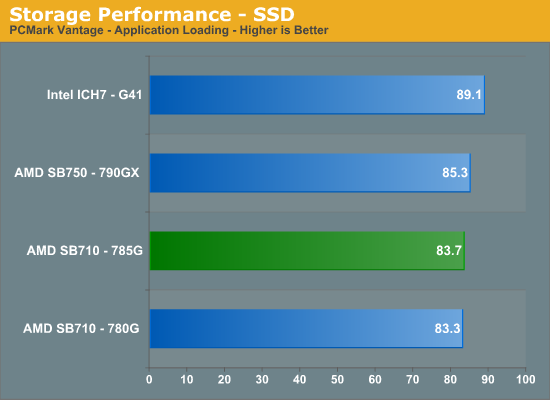
Even though the ICH7 is feature limited, it still maintains to lead the SB710/SB750 Southbridges in our Vantage performance tests. The total suite score favors the ICH7 by 2% while the application loading test suite indicates the SB710 is about 6% slower in this particular benchmark that reflects most SOHO usage patterns.
The latest AMD SSD tuned SB driver increased our total suite score from 16432 to 24653 and the application loading score from 59.1MB/s to 83.7 MB/s compared to the inbox Windows 7 driver. We did not notice any performance differences between the inbox Intel driver and the latest driver update from Intel. That said, the AMD driver properly disabled Prefetch, Indexing, and Defrag on our SSD while the Intel driver left these items enabled on the ICH7 system.
Transfer Tests -
In these two particular tests, we are concentrating on transfer throughput from our WD 300GB VelociRaptor to our 80GB Kingston SSD (Intel X25-M) SSD. Our first test consists of transferring a folder that is 2.31GB in size and contains our 35 test videos. The second test consists of a folder that is 1.08GB in size and contains 2454 files of various documents and images.
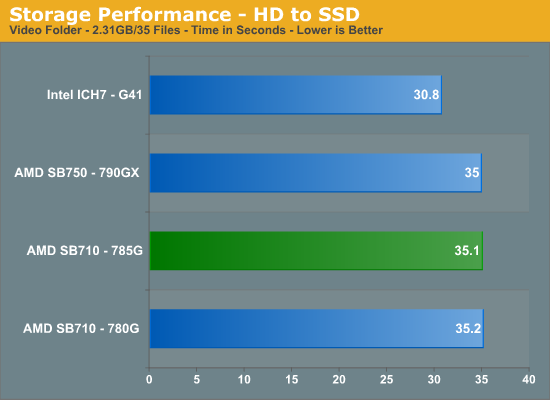
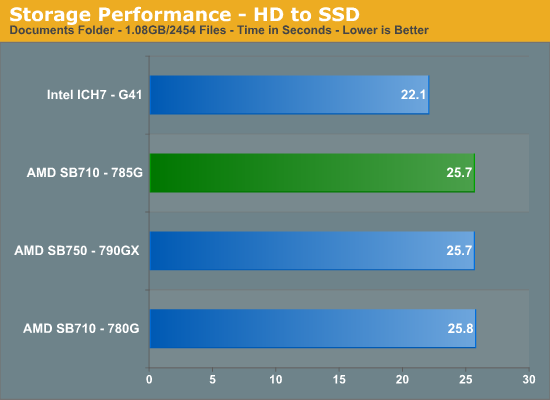
In the large file test, the ICH7 is about 13% quicker than the SB710. The small file transfer test has the ICH7 retaining a 14% lead over the SB710. Regarding both results, we never noticed the AMD system being slower than the Intel system in daily usage.
USB Performance -
AMD rightly took a lot of blame for poor USB performance in the SB450/SB600 Southbridges and set off to correct these problems in the latest SB7xx series. For the most part they have succeeded. However, we discovered that utilizing HDTach or similar programs showed that AMD was still a step behind Intel and NVIDIA although this is something we never noticed in daily usage.
Our two USB transfer tests focus on file transfers from our SSD OS drive and our secondary HD to an external 1TB unit from Lacie. The first test consists of transferring a folder that is 954MB in size and contains 28 various files ranging from short videos to PDF files. The second test consists of a folder that is 1.08GB in size and contains 2454 files of various documents and images.
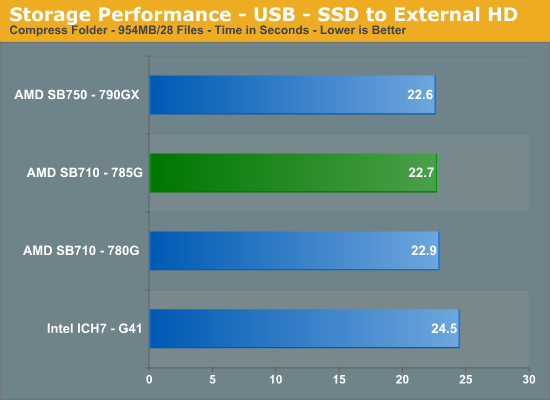
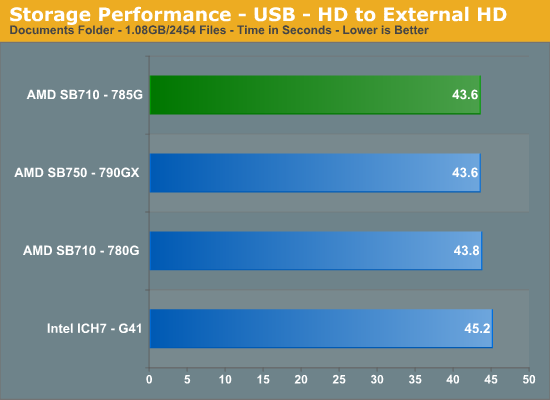
In the first test, the SB710 is 7% quicker than the ICH7. Our second transfer test indicates the SB710 is 4% faster than the ICH7.










43 Comments
View All Comments
Hrel - Saturday, August 22, 2009 - link
You showed Nvidia stats on the first page... I guess you didn't include them cause ATI and Intel can't even compare???Next time include the Nvidia results... would've thought that it'd an impulsory action; guess not.
crochat - Tuesday, August 18, 2009 - link
Gary,You mentioned a motherboard roundup in your conclusion. I thought it would come sooner.
Regards
AlB80 - Sunday, August 16, 2009 - link
1. The A-Link Express II is a proprietary interface developed by AMD basing on the PCI Express Gen2 version 2.0 technology, with additional Northbridge-Southbridge messaging functionalities.2. High data transfer bandwidth (up to 2.5 Gb/s / Lane)
Concillian - Saturday, August 15, 2009 - link
"Remember when ATI made crappy chipsets that no one bought, and all AMD systems were built with NVIDIA or even VIA chipsets? "Yeah, I remember that, thats when they were really AMD chipsets and not ATi chipsets with an AMD label on them. ATi started making good Crossfire chipsets shortly before AMD bought them.
I like AMD as much as the next guy, but let's not be patting them on the back too hard. They tried, failed, then did what any good American businessman would do... bought a struggling competitor to use their IP.
IntelUser2000 - Saturday, August 8, 2009 - link
Gary, you got the clock speed of the G41 IGP wrong:http://www.techarp.com/showarticle.aspx?artno=543&...">http://www.techarp.com/showarticle.aspx?artno=543&...
G41 and G43 uses a 667MHz core while G45 uses 800MHz.
Notice the differences here: http://global.hkepc.com/1525/page/3#view">http://global.hkepc.com/1525/page/3#view
ClagMaster - Saturday, August 8, 2009 - link
The 785G is just a 780G which has recieved a fine tuning. Which is OK. There are slight improvements in performance over the 780G but nothing to be excited about. 785G Seems to work well with DDR3 memory and Athlon II processors.I have an ASUS M3A78EM 780G Mobo with an AMD BE2400 X2 CPU I use as a secondary computer I keep off-line for private matters. It's a fairly powerful rig for the media applications I run.
The HD 3200 GPU is just as powerful as a Geforce 4200 graphics card. I can play DX8 and DX9 games from the 2002-2004 period (Max Payne, Aquanox, Homeworld2) with acceptable framerates at 1280 x 1024 resolution. I run Windows XP Home.
The 785G is not bad. But if I had a choice between a 785G mobo and a 780G mobo with the 780G costing $5-$10 less, I would buy the 780G mobo. I can still run Windows 7 with the 780G with the HD3200.
ClagMaster - Saturday, August 8, 2009 - link
BTW-This article was not boring. It honestly compared the performance capabilities of the 785G to other chipsets of its class (780G and G41).
Most differences between the 785G and 780G were small and within the combined statistical uncertainty of the benchmark measurements measurements +/-10% (i.e. statistically insignificant). Not very surprising. Most of the larger differences observed were between systems with DDR2-1066 and DDR3-1333 memory systems.
I agree the 785G is a better balanced chipset than the 780G and G41 for multimedia.
I wish Gary would have used an older benchmarking suite so I can compare the performance between current and systems 2-3 years old. I prefer PCMark2005 and 3DMark2005 since these are reliable indicators of performance. This is important to me because I try to make my purchasing decisions on the criteria of having double the performance for the same cost and power consumption.
ClagMaster - Saturday, August 8, 2009 - link
BTW-This article was not boring. It honestly compared the performance capabilities of the 785G to other chipsets of its class (780G and G41).
Most differences between the 785G and 780G were small and within the combined statistical uncertainty of the benchmark measurements measurements +/-10% (i.e. statistically insignificant). Not very surprising. Most of the larger differences observed were between systems with DDR2-1066 and DDR3-1333 memory systems.
I agree the 785G is a better balanced chipset than the 780G and G41 for multimedia.
I wish Gary would have used an older benchmarking suite so I can compare the performance between current and systems 2-3 years old. I prefer PCMark2005 and 3DMark2005 since these are reliable indicators of performance. This is important to me because I try to make my purchasing decisions on the criteria of having double the performance for the same cost and power consumption.
7Enigma - Thursday, August 6, 2009 - link
Gary,Thanks for the article but could you keep in mind for future articles on non-gaming hardware (i.e. IG's, budget GPU's, etc.) to make sure the game description is in line with the actual article? I can tell they were just copied directly from a previous gaming article, so it's a bit silly to see, "We crank up all the details to max", only to see the data chart show 1024X768 with low settings.
:)
AlB80 - Wednesday, August 5, 2009 - link
DMI 10Gb/s each direction, full duplexaka
4 lane PCIe 1.1